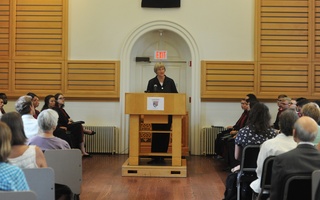Isaac Royall Jr., in the words of one Harvard Law professor, was “a brutal slaveholder.” He was born into a colonial-era family of wealthy Triangle Trade merchants and owned about sixty slaves by our best estimates. At one point, Royall and his father brokered the sale of 121 human beings in one day. Another time, they had 77 slaves burned alive at the stake following a failed rebellion.
In his 1779 will, Royall left land for Harvard College to establish its first professorship in law. The donation grew into the founding of Harvard Law School, whose seal to this day includes three sheaves of wheat—the Royall family’s coat of arms.
The more you read into Royall’s history, the eerier this connection becomes. In his professional pursuits, Royall was everything that Harvard—and really any modern institution—stands against. Royall was deeply bigoted. And herein lies the compelling logic behind the new “Royall Must Fall” student movement that is urging the Law School to change its seal.
But a deeper look into history shows that cleansing Harvard of slavery’s legacy would be more difficult than it seems.
In 2007, Laird Bell Professor of History Sven Beckert, along with 33 students, launched an ambitious investigation of Harvard’s past implication with slavery. The 36-page report found that “Harvard’s history entails a whole range of connections to slavery.”
The report noted that in colonial times, students ate meals and slept in beds prepared by slaves. Harvard Presidents Increase Mather, Benjamin Wadsworth, and Edward Holyoke all owned slaves, as did First Church of Cambridge Minister William Brattle. That’s one Residential House, one building in the Yard, and two streets in the Square.
When slavery was finally outlawed in Massachusetts during the American Revolution, Harvard had already been around for almost 150 years.
But Harvard’s dark past doesn’t stop there. According to Law School visiting professor Dan Coquillette, who recently published a book about the Law School’s early history, the story continues through the Civil War.
“Leaders of the school, [like Professor] Emory Washburn, told the students in 1860 not to discuss slavery,” Coquillette was recently quoted in The Harvard Law Record. “The school had so many southern alumni, partially because the school marketed aggressively in the South. There were 600 graduates of the school in the Deep south and they were all in positions of leadership after the war. The Mayor of Atlanta, Governor of South Carolina, founder of the University of Texas.”
These examples point to the impossibility of erasing history. Should the Royall Must Fall campaign succeed in changing the Law School’s seal, it would only be a drop in the bucket towards an impractical goal of changing every namesake with a connection to a past filled with different moral standards than those we have today.
As far as I know, there are no pro-slavery individuals on campus using the Law School’s crest as a rallying cry. One would be hard-pressed to find an individual at Harvard who did not object to Royall’s slaveholding. Thus, getting rid of the seal would serve no real political good. This is what differentiates the Law School’s seal from the South Carolina capitol’s Confederate battle flag, which was taken down because it was a source of pride for many.
Yale is now having a similar discussion with regards to Calhoun College, a residential dorm whose namesake (after one of American history’s foremost slavery advocates) is inappropriate in the eyes of some students.
Yale Dean Jonathan Holloway weighed in, saying that instead of renaming Calhoun, it should remain “as an open sore, frankly, for the very purpose of having conversations about this.”
Holloway continued, “I’ve seen too many instances where Americans have very happily allowed themselves to be amnesiac and changed the name of something and walked away.”
If the Law School changed its crest, it would simply generate a “so what?” question. It would serve no political or symbolic good, while effectively exempting the need for any conversation on the subject. Rather than the Royall coat of arms falling from the Law School seal, it should remain as a reminder of Harvard’s darker past and the drastically different moral code we embrace today.
Aaron J. Miller ’18, a Crimson editorial writer, lives in Currier House.
Read more in Opinion
Small StepsRecommended Articles
-
Pledging His Life To Fight SlaveryWhen Gerald L. "Jay" Williams '03 first came upon a clearing where hundreds of newly freed Sudanese slaves sat under
-
Respect the Past: Remove the Royall SealThe truth is we don’t need the names or insignias of racists to remind us of slavery or Jim Crow. We see it every day in mass incarceration, police shootings, childhood poverty and the $20 bill.
-
Letter to the Editor: Remember Royall's SlavesIs it not realistic to say that the law school is not Royall’s legacy, but is rather the slaves’ legacy, thanks to the wealth they created?
-
 Faust Will Dedicate Plaque to Honor Harvard Slaves
Faust Will Dedicate Plaque to Honor Harvard Slaves -
 Faust Calls for Confronting the Past Ahead of New School Year
Faust Calls for Confronting the Past Ahead of New School Year













